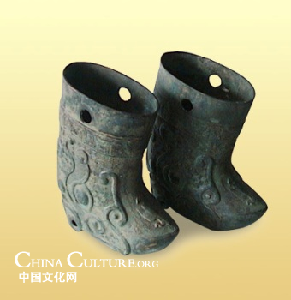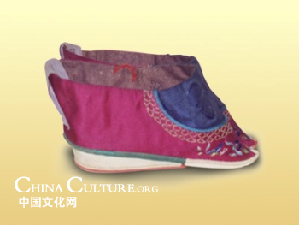Chinese Way
Ancient Chinese shoes
Updated: 2008-09-26 09:37
(chinaculture.org)
This pair is a handicraft. The Panli decoration on the boots is a typical pattern from the Warring States (475–221 BC). This kind of shoe was introduced to the State of Zhao from the Hu ethnic group, which was the first great innovation in shoe culture in Chinese history. During the Warring States, the king of Zhao introduced the Hu ethnic group’s shoes and clothes into his country so that the army could move more quickly in battle. Therefore, the State of Zhao became one of the seven strongest states at that time. The appearance of boots radically changed military life, political life and even Chinese society. From then on, boots were martial shoes as well as everyday shoes which spread all over the country.
Lily feet refers to women's bound feet. The origin of lily feet is not very certain. It is often said that it appeared during the Five Dynasties (907–960). According to legend, a king asked a lady-in-waiting named Ruiniang to bind her feet and dance on a golden lotus flower, so it was called three-inch lily feet. After that, the custom of foot-binding emerged. But this custom ceased after the founding of New China, and shoes for lily feet entered the museums. There is another story about lily feet. The king of the Sui Dynasty (581–618) was immoral. When he traveled along the river, he did not want to use men to tow his boat, so he chose 100 beautiful women. A blacksmith’s daughter, Wu Yueniang, was one of them. She bound her feet and hid a small sword inside. She wore very beautiful small shoes with lotus flowers which attracted the king's attention. When the king came closer to look, Wu Yueniang drew out the sword and stabbed the king's arm. Wu Yueniang failed to kill the king; then she jumped into the river and killed herself. From then on, women began binding their feet to memorialize Wu Yueniang.
Flowerpot-sole shoes in the Qing Dynasty. Women from the Manchu ethnic group liked to wear long dresses but found it inconvenient to walk. Thus, they added a special kind of thick sole under their shoes. The sole looked like flowerpots, so they were called flowerpot-sole shoes. According to legend, they made a rhythmic sound that would drive bad animals away. Another reason for wearing the flowerpot-sole shoes was that they supposedly made women slimmer and more coquettish.
Specials

President Hu visits the US
President Hu Jintao is on a state visit to the US from Jan 18 to 21.

Ancient life
The discovery of the fossile of a female pterosaur nicknamed as Mrs T and her un-laid egg are shedding new light on ancient mysteries.

Economic Figures
China's GDP growth jumped 10.3 percent year-on-year in 2010, boosted by a faster-than-expected 9.8 percent expansion in the fourth quarter.


